Rustic Farmhouse Interior Design: 13 Tips for Absolute Timeless Elegance

Table of Contents
Welcome to the world of Rustic Farmhouse Interior Design, a style that encapsulates the charm of bygone eras while seamlessly integrating into modern homes.
This design aesthetic is a celebration of simplicity, warmth, and a connection to nature, making it a perennial favorite among homeowners and interior design enthusiasts alike.
Rustic farmhouse interior design is a captivating blend of rugged, weathered elements with the comfort of a rural farmhouse.
This style draws inspiration from the simplicity of country living, embracing imperfections and highlighting the beauty found in natural materials.
The charm of rustic farmhouse design lies in its authenticity.
From exposed beams and reclaimed wood to vintage-inspired decor, every element tells a story and adds character to the space.
It’s a style that transcends trends, offering a comforting aesthetic that stands the test of time.
One of the reasons rustic farmhouse interior design endures is its timeless nature.
Unlike fleeting trends, this style isn’t bound by the constraints of passing fads.
Instead, it draws inspiration from the enduring beauty of the countryside, capturing the essence of generations past.
The result is a design that feels both contemporary and rooted in tradition, making it a versatile choice for a range of home settings.
I. Key Elements of Rustic Farmhouse Interior Design

A. Colors and Palette of Rustic Farmhouse Style
Earthy Tones and Muted Colors:

Rustic farmhouse interior design thrives on a palette inspired by the natural world.
Earthy tones such as warm browns, soft greens, and muted grays form the foundation of this aesthetic.
These colors create a serene backdrop that evokes the tranquility of the countryside.
Embracing Natural, Warm Hues:


Infuse your space with warmth by embracing natural hues.
Think about the cozy ambiance of a rustic cabin—opt for warm whites, creamy beiges, and subtle yellows.
These colors not only brighten the space but also contribute to the inviting atmosphere that defines the rustic farmhouse style.
B. Rustic Farmhouse Materials
Reclaimed Wood as a Primary Material:

Central to the rustic farmhouse charm is the use of reclaimed wood.
Whether it’s for flooring, beams, or furniture, reclaimed wood brings a sense of history and authenticity to the space.
The imperfections in the wood tell a story, adding character and a touch of nostalgia.
Exposed Brick and Stone:

Incorporate the rugged beauty of exposed brick and stone to enhance the rustic appeal.
These materials not only contribute to the timeless aesthetic but also provide texture and a visual focal point.
The juxtaposition of natural elements creates a captivating interplay in the design.
Incorporating Metal Accents for a Touch of Industrial:

To add an industrial edge to the rustic warmth, consider incorporating metal accents.
Wrought iron, steel, or copper elements introduce a hint of modernity to the design.
From light fixtures to hardware, these accents complement the organic feel of the space.
C. Rustic Farmhouse Furniture
Distressed and Vintage Furniture Pieces:

The furniture in a rustic farmhouse interior is a harmonious blend of comfort and character.
Opt for distressed and vintage pieces that showcase wear and age.
These elements not only add a sense of history but also create a lived-in, comfortable ambiance.
Mixing Textures and Finishes for a Lived-In Feel:
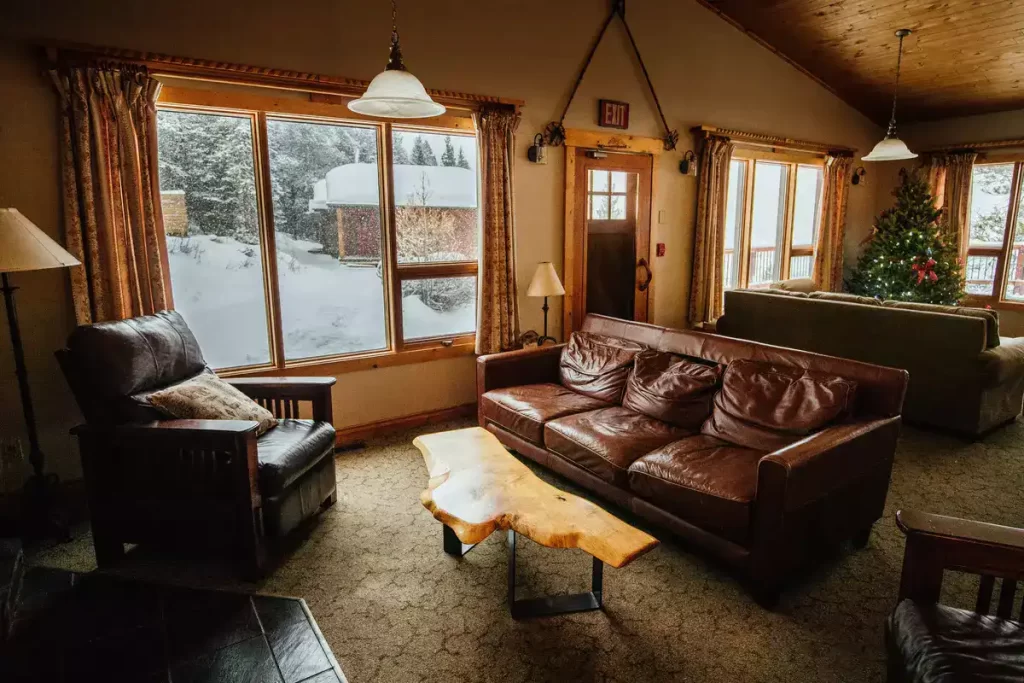
Create visual interest by mixing textures and finishes in your furniture selection.
Pairing a distressed wooden coffee table with a plush upholstered sofa, for example, adds layers and richness to the design.
The goal is to achieve a curated, collected-over-time aesthetic.
Incorporating Farmhouse-Style Tables and Chairs:

Anchoring the space with farmhouse-style tables and chairs completes the rustic farmhouse look.
These pieces often feature sturdy, well-worn materials and simple, functional designs.
From the dining area to the kitchen, farmhouse-style furniture ties the entire design together.
As you weave these key elements into your rustic farmhouse interior, remember that the beauty lies in the harmony of natural materials, muted colors, and vintage-inspired furnishings.
II. 14 Tips for Achieving Rustic Farmhouse Interior Design
1. Celebrate the Beauty of Worn and Weathered Surfaces

Rustic farmhouse design is all about embracing imperfections.
Instead of shying away from worn and weathered surfaces, celebrate them.
Let the scratches on a wooden coffee table or the patina on a vintage mirror tell a story.
These flaws give your place character and authenticity.
2. Distressed Finishes for Furniture and Décor Items

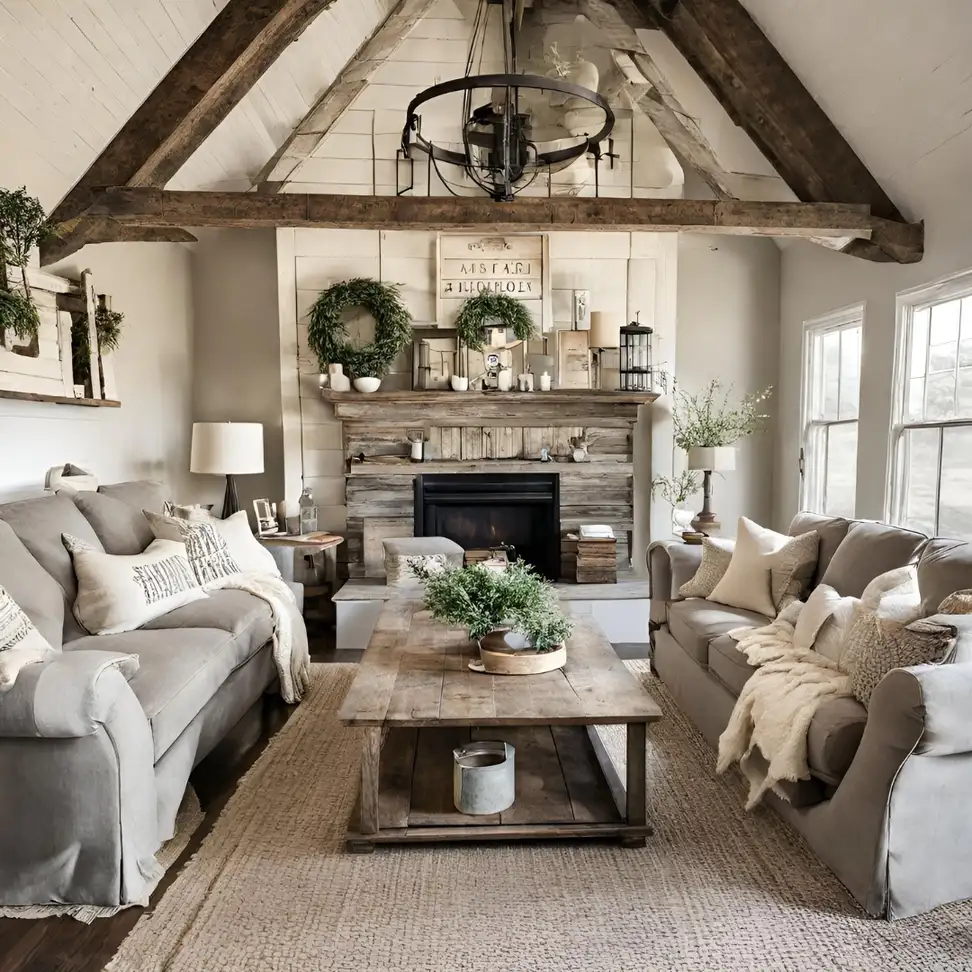
Opt for furniture and decor items with distressed finishes.
This intentional weathering gives pieces the appearance of age, making them feel like cherished heirlooms.
Whether it’s a distressed wooden sideboard or a well-worn farmhouse sign, these touches contribute to the overall rustic charm.
3. Incorporate Cozy and Textured Fabrics
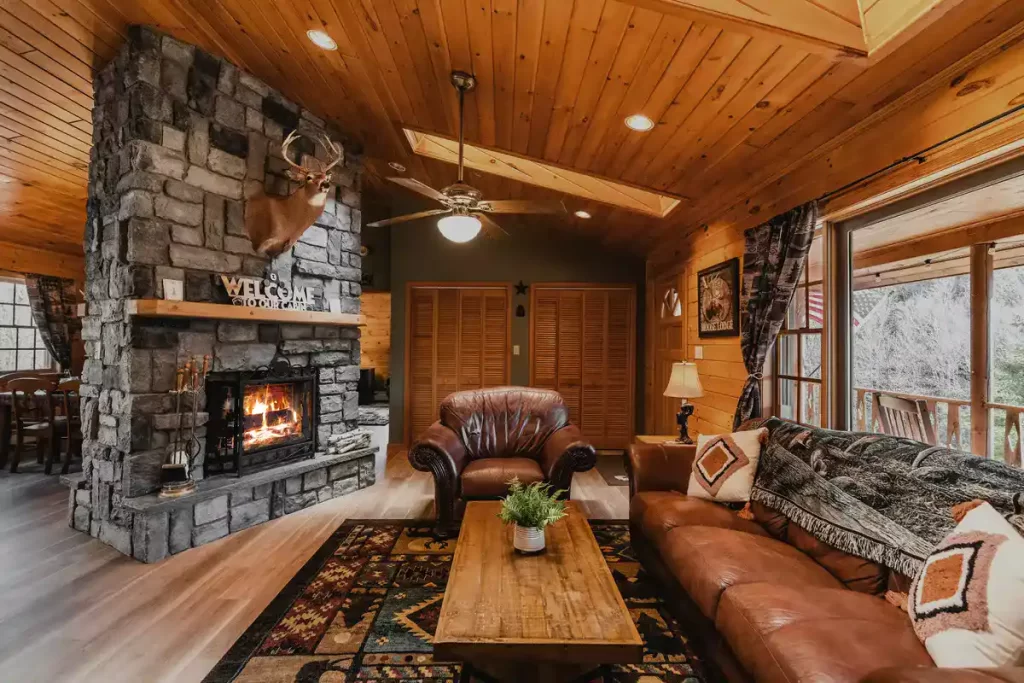
Infuse your space with warmth by incorporating cozy and textured fabrics.
Choose plush throws, chunky knit blankets, and soft area rugs to create a tactile experience.
These textiles not only add comfort but also enhance the inviting atmosphere that defines rustic farmhouse design.
4. Utilize Vintage-Inspired Textiles like Burlap and Linen

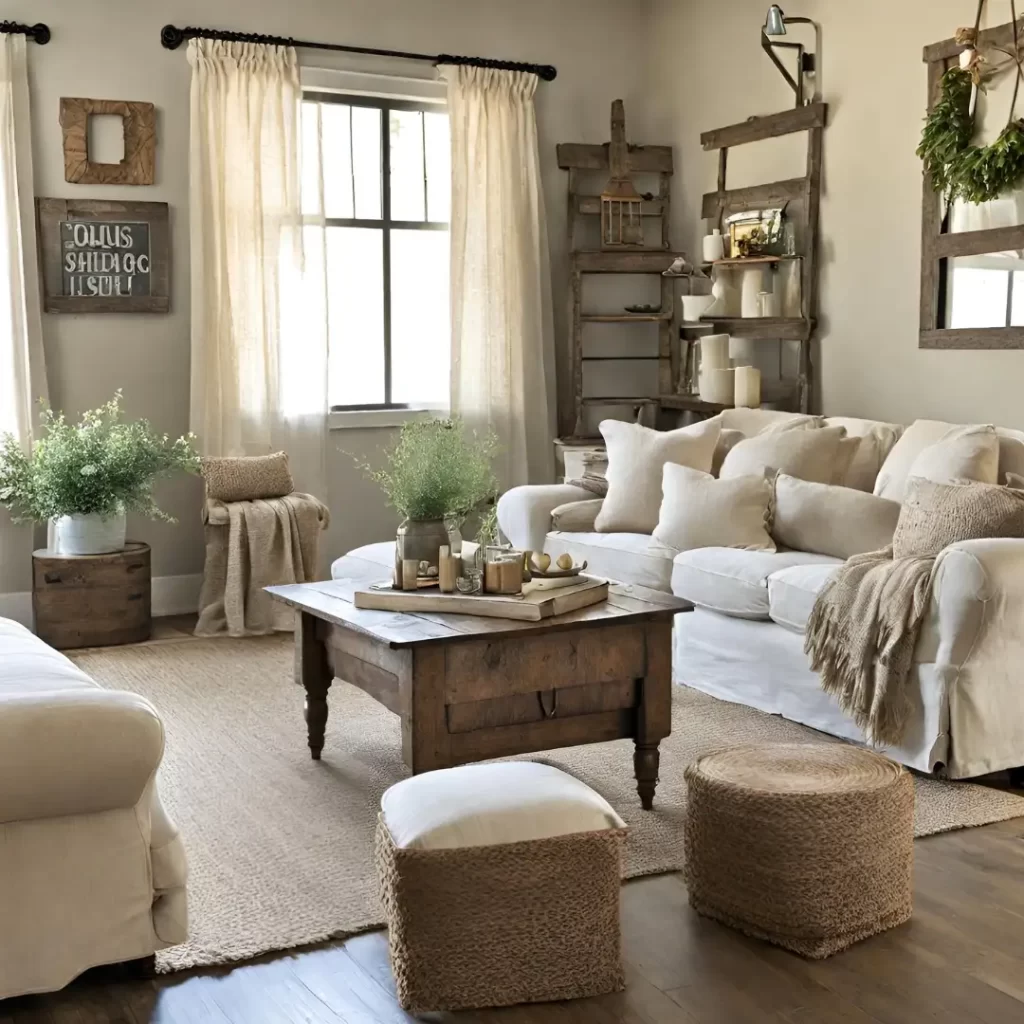
Bring in vintage-inspired textiles like burlap and linen to evoke a sense of nostalgia.
Consider using these fabrics for throw pillows, curtains, or table runners.
The natural, slightly coarse texture of these materials complements the rustic aesthetic, adding depth and visual interest.
5. Showcase Farmhouse-Style Dishware and Décor


Open shelving is a hallmark of rustic farmhouse interior design.
Use it as an opportunity to showcase farmhouse-style dishware and decor.
Arrange vintage plates, mugs, and rustic accessories to create a curated display.
This not only adds personality to your kitchen but also serves as functional decor.
6. Create a Sense of Openness in the Kitchen or Living Areas

Open shelving isn’t just about display—it also creates a sense of openness in the kitchen or living areas.
Instead of closed cabinets, opt for open shelves to visually expand the space.
This design choice fosters a feeling of airiness and encourages a more relaxed, lived-in atmosphere.
7. Repurpose Antique Doors
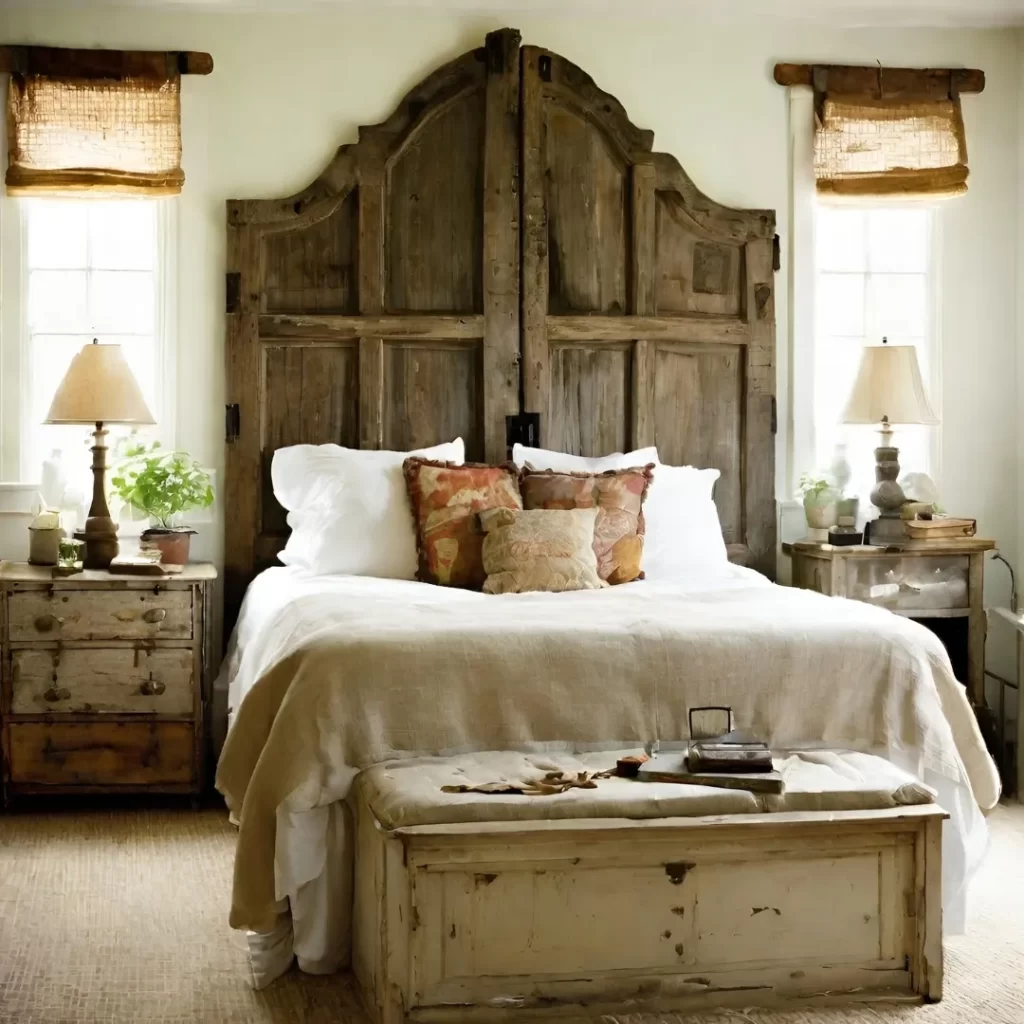
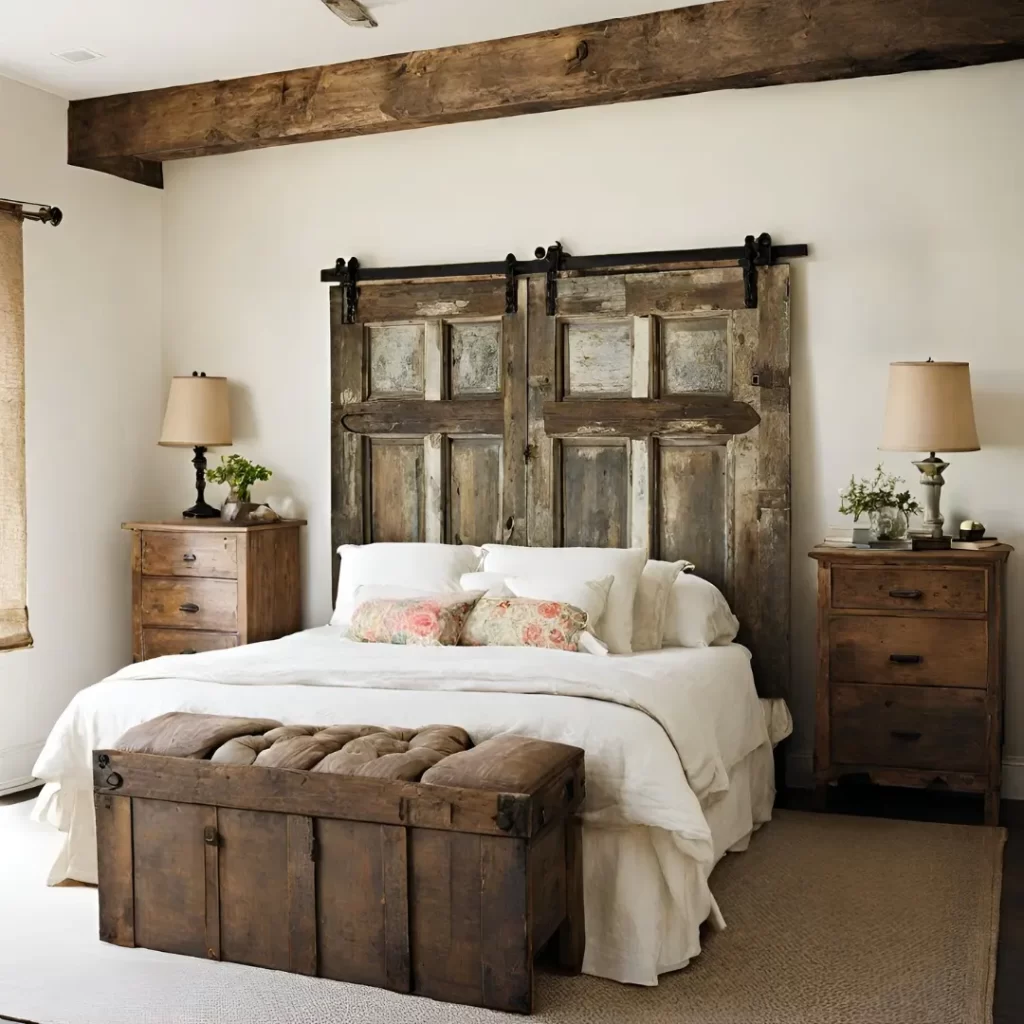
For a one-of-a-kind focal point in your bedroom, consider using salvaged antique doors as a headboard.
The weathered patina and intricate details on the doors add a touch of history and uniqueness to your sleeping space, creating a rustic farmhouse haven.
8. Maximize Natural Light

Harness the beauty of natural light by strategically placing windows throughout your space.
Optimize the placement of windows to capture the maximum amount of sunlight.
Consider installing large, farmhouse-style windows with divided panes to enhance the architectural charm while flooding the interior with natural brightness.
9. Sheer or Light Fabric Curtains for an Airy Feel
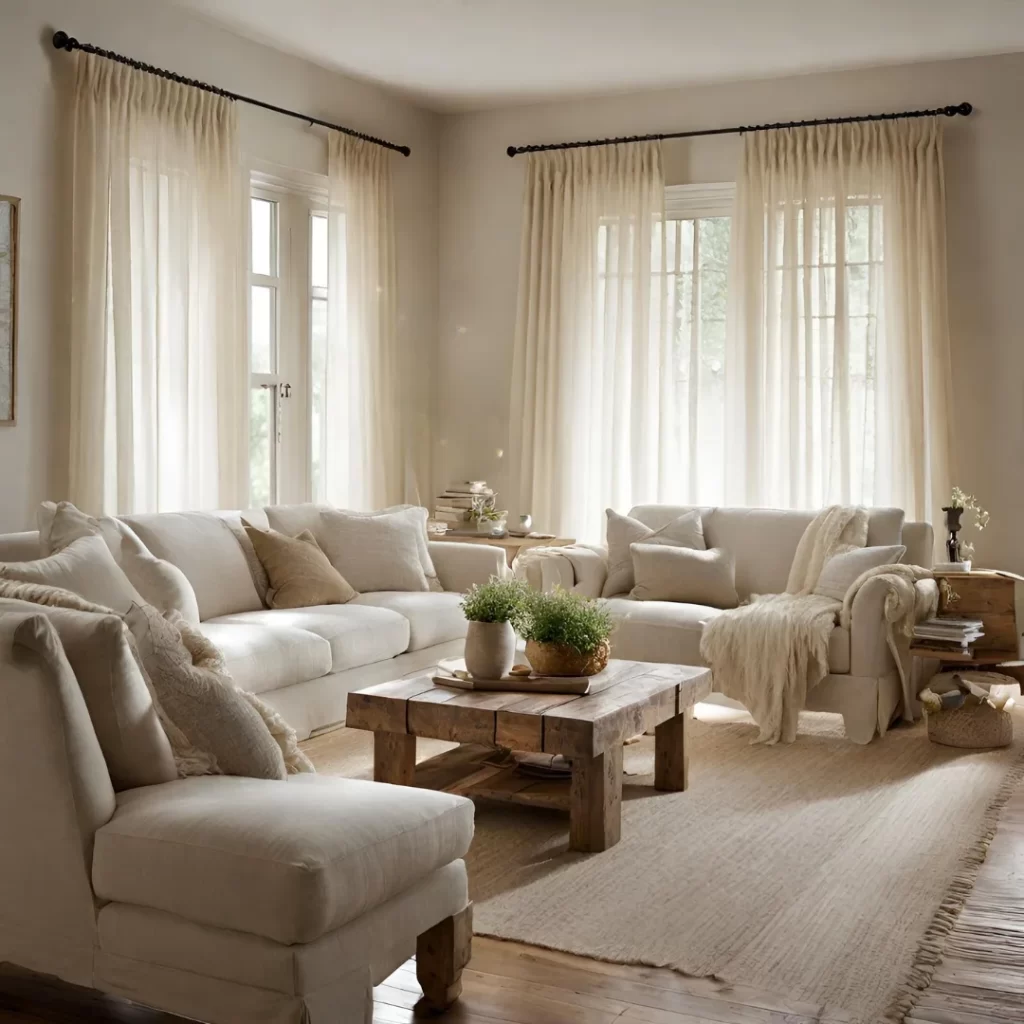

Complement the abundance of natural light with sheer or light fabric curtains.
Choose fabrics like linen or cotton in neutral tones to maintain an airy feel.
These curtains not only diffuse sunlight, creating a soft glow but also add a touch of casual elegance.
10. Incorporate Wrought Iron or Metal Pendant Lights
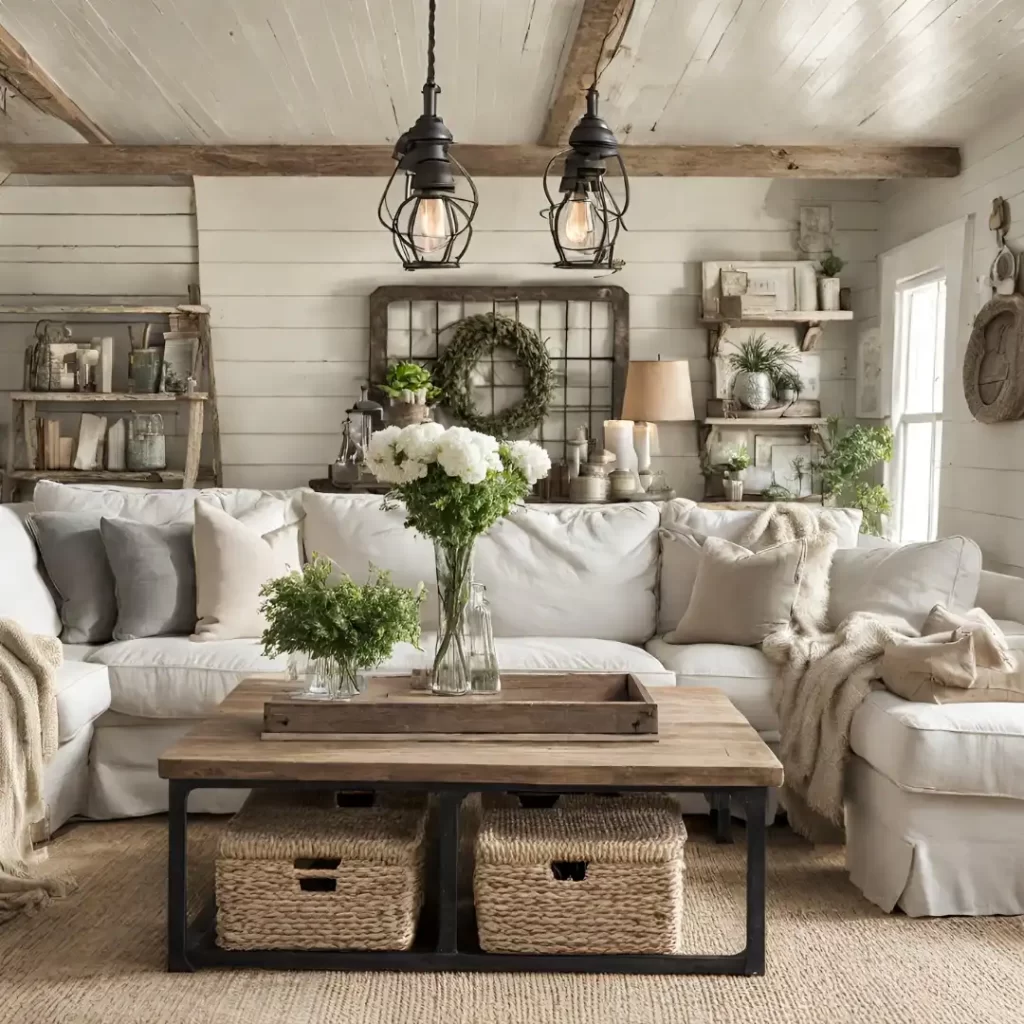

Make a bold statement in your rustic farmhouse interior by incorporating wrought iron or metal pendant lights.
These fixtures add an industrial touch while maintaining the rugged elegance of the farmhouse aesthetic.
Hang them over kitchen islands, dining tables, or entryways to create a focal point that draws the eye.
11. Fresh or Faux Greenery to Bring the Outdoors In

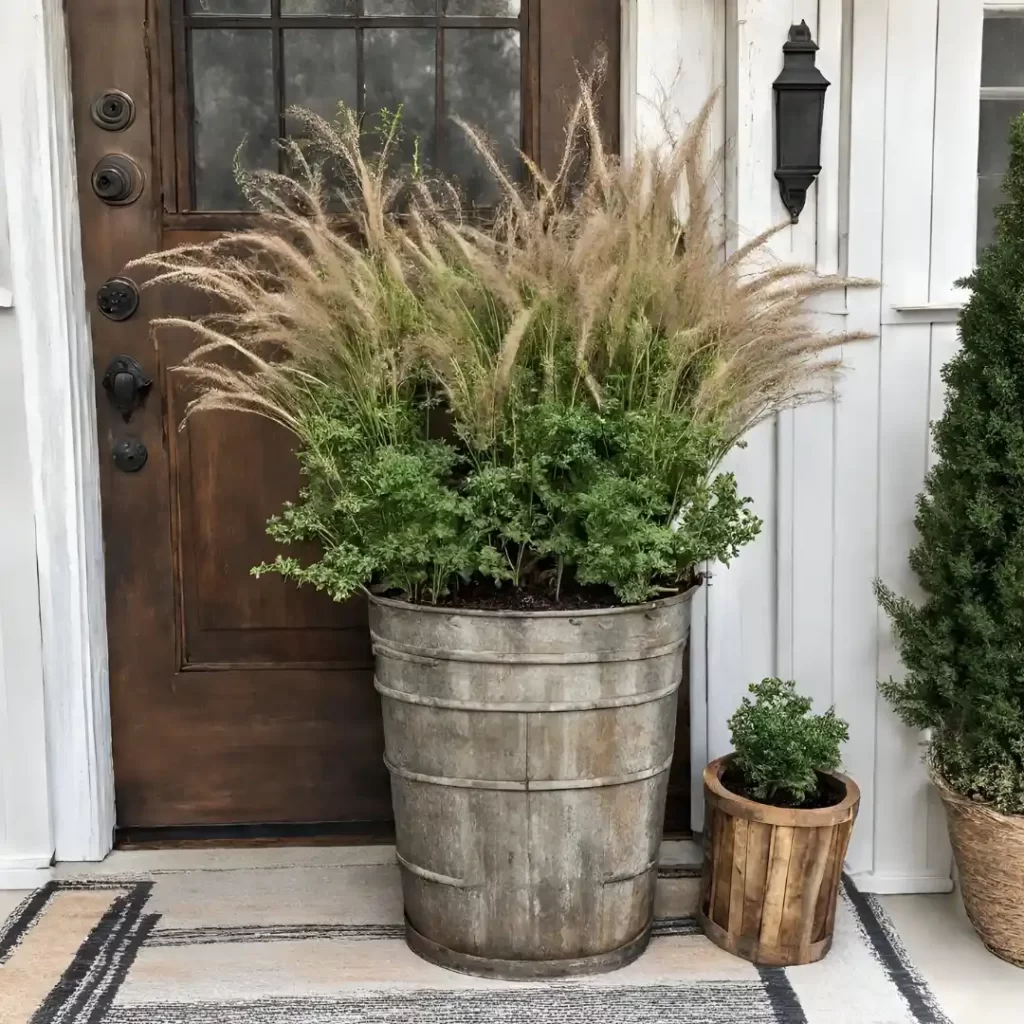
Liven up your rustic farmhouse interior with vibrant hues of fresh or faux greenery.
Place potted plants on windowsills, countertops, and tables to bring the outdoors inside.
This not only adds visual interest but also introduces a refreshing natural element, creating a harmonious connection with the surrounding environment.
Use Jars or Rustic Containers as Planters.
Mason jars, galvanized buckets, or weathered wooden crates make charming and unconventional plant holders.
12. Hunt for Unique Vintage Pieces at Flea Markets or Thrift Stores

Embark on a treasure hunt at flea markets or thrift stores to discover unique vintage pieces.
Look for weathered frames, old-fashioned kitchenware, or charming artifacts that tell a story.
These vintage finds add character and a sense of history to your rustic farmhouse interior.
13. Incorporate your vintage treasures to Add Character and History


Once you’ve unearthed your vintage treasures, strategically incorporate them into your décor.
Arrange vintage books on coffee tables, display antique frames on walls, or use old crates as storage.
Integrating these findings seamlessly into your design adds character and a layer of history, making your space feel rich with nostalgia.
Incorporating these tips into your rustic farmhouse interior design will not only enhance the aesthetic appeal but also create a home that feels welcoming and authentic.
These thoughtful touches will undoubtedly elevate your space to embody the essence of rustic farmhouse charm.
III. Contemporary Rustic Farmhouse Elegance.

Modern Rustic Farmhouse represents a captivating fusion of classic charm and contemporary innovation, seamlessly marrying the warmth of tradition with the sleek lines of modern design.
Think of it as a marriage of tradition and innovation, resulting in a space that feels both timeless and up-to-date.

This style embraces a neutral color palette, incorporating whites, grays, and natural tones while infusing pops of contrast with bold, contemporary hues to create visual interest.
Integrating sleek and clean-lined furniture into the rustic setting achieves a modern vibe, with minimalist sofas and tables complementing the ruggedness of reclaimed wood and distressed finishes.
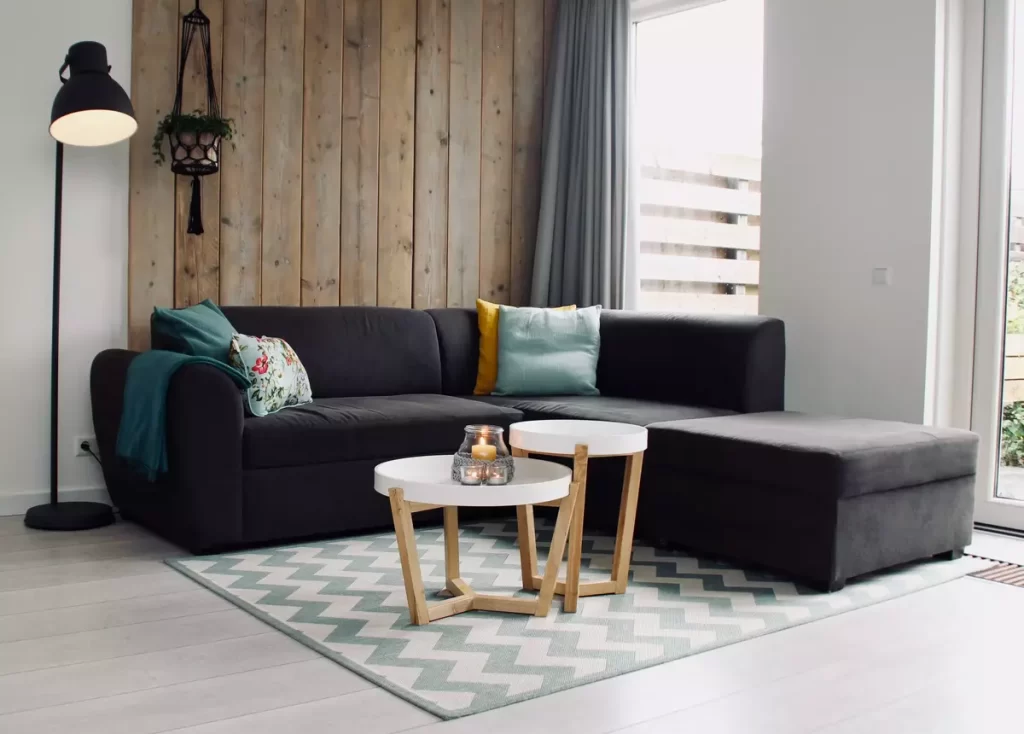
The use of mixed materials adds texture and depth, combining polished concrete, glass, and exposed brick to create a visually dynamic space.
Open-concept living spaces are embraced, removing unnecessary partitions to enhance the spacious and airy feel characteristic of both rustic and contemporary design.

Lighting fixtures become statement pieces, with geometric pendant lights and sculptural chandeliers adding a modern edge while illuminating the rustic elements of the space.
Achieving a harmonious balance requires a thoughtful approach, with personalized focal points, layered textures, and strategic use of contemporary accents to create a living space that is both timeless and current.
IV. Bringing Rustic Farmhouse to Different Spaces
A. Rustic Farmhouse Living Room

Transform your living room into a rustic farmhouse haven with cozy furniture arrangements.
Opt for comfortable seating like overstuffed sofas and armchairs, arranged in a way that fosters conversation.
Create an inviting focal point, perhaps around a fireplace or with a statement coffee table, to anchor the room.
B. Rustic Farmhouse Kitchen

Bring the rustic farmhouse charm into your kitchen by embracing open shelving.
Display farmhouse-style dishware, vintage utensils, and woven baskets on these shelves.
This not only adds a decorative element but also makes practical items easily accessible, contributing to the functionality of the space.
Consider vintage-inspired appliances, like a retro-style refrigerator or stove, to infuse charm into the heart of your home.
C. Rustic Farmhouse Bedroom

Create a tranquil rustic farmhouse retreat in your bedroom by incorporating a reclaimed wood headboard.
The natural, weathered charm of reclaimed wood adds character and a touch of history to the space.
This focal piece anchors the room, setting the tone for a cozy and inviting sanctuary.
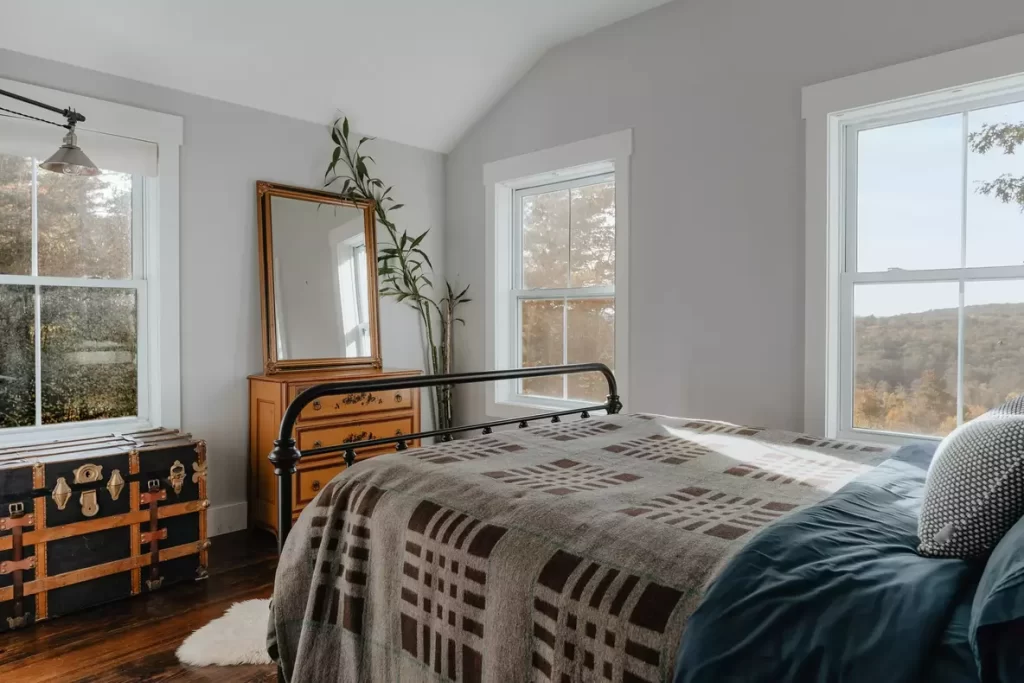
Choose linens and duvet covers in muted tones, complemented by touches of rustic charm such as crochet throws or woven blankets.
Introduce farmhouse-style bedside tables or lamps to complete the cohesive aesthetic.
Bringing rustic farmhouse design to different spaces involves thoughtful curation of elements that capture the essence of the style.
From creating cozy living room arrangements to infusing farmhouse charm into the kitchen and bedroom, each space becomes a canvas for expressing the warmth and timelessness associated with rustic farmhouse interiors.
In conclusion, as we’ve journeyed through the world of rustic farmhouse interior design, we’ve explored key elements, gathered tips, and uncovered trends that breathe life into living spaces.
As you embark on your rustic farmhouse design journey, remember that this style is not just a set of guidelines but an opportunity to reflect your personality and create a home that tells your unique story.
If you find yourself inspired but in need of guidance or assistance in translating your vision into reality, we’re here for you.
Our team of professional interior designers is passionate about turning spaces into personalized sanctuaries.
Whether you’re looking for advice, a full design overhaul, or just a fresh perspective, don’t hesitate to reach out.
Your dream rustic farmhouse interior is just an email or phone call away.
